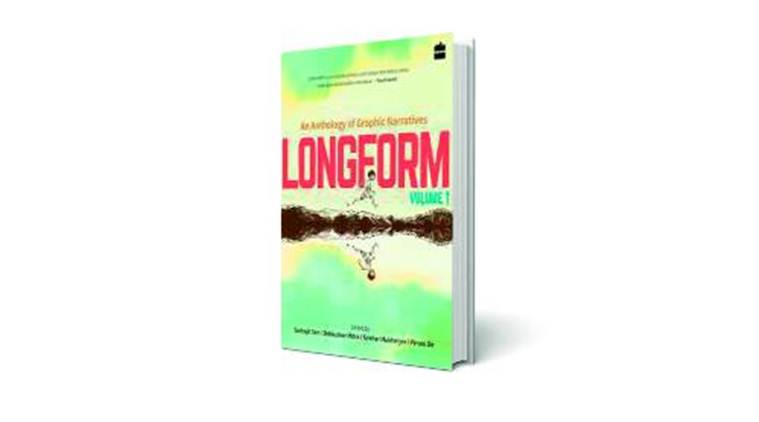Let the Adventure Begin
An ambitious compilation of works by 31 Indian and international artists that explore forms of graphic art beyond comics.
Written by Priya Kuriyan | Updated: July 14, 2018 12:02:24 pm

From stories of people living at the margins of society to personal musings of artists offering a slice of life, the stories in Longform-1 cut across diverse genres and themes with varying results.
Book: Longform Volume 1: An Anthology of Graphic Narratives
Edited by: Sarbajit Sen, Debkumar Mitra, Sekhar Mukherjee, Pinaki De
Publisher: Harper Collins
Page: 398
Price: Rs 1,499
Longform Volume-1, the latest anthology to enter the Indian comic scene, is an ambitious compilation of the works of 31 artists from India, France, Iran, Korea, Switzerland and Bhutan. Edited by Pinaki De, Sarbajit Sen, Debkumar Mitra and Sekhar Mukherjee, the contributions to the book are not restricted to comics alone. The book takes off unravelling drawings from the sketchbook of Swiss artist Bardoux during his travels across India. Berlin-based Allen Shaw’s beautiful watercolours while on an Italian sojourn form part of the book as well. An extended interview with filmmaker Sandip Ray is replete with anecdotes about his father Satyajit Ray’s fascination with comics — how comics influenced his own childhood, and, later, his process of filmmaking.
The title of the anthology is a hat tip to Joe Sacco, who once commented on the lack of interest shown by newspapers and magazine editors when it came to long form graphic narration. The title, however, is a tad bit misleading — even though there are a few long narratives that form the crux of this anthology, the majority of the pieces do not extend to more than four or five pages.
From stories of people living at the margins of society to personal musings of artists offering a slice of life, the stories in Longform-1 cut across diverse genres and themes with varying results. Prakash Moorthy’s visceral story ‘If in the Shadows of a Leopard’ , based on the myth of the Odiyans or shape-shifters of the Malabar region of Kerala, is a scathing reminder of the caste system that was prevalent in Kerala in the 14th century, the remnants of which still cling on. It grips you with its suspenseful and deliberate narration that often surpasses the visuals.
Sarbajit Sen and Sekhar Mukherjee serve two delectable stories centered around food. The first, a dark and twisted tale called ‘Dodo and the Food Fetish’ is about an introverted single man’s obsession with food; how it consumes him and obstructs his romantic relationships. Mukherjee’s ‘The Magical Kitchen of Maria Alfonso Caramelo Lobo’ is an ode to the famous La Bella Auntie of Ahmedabad. Anyone who has been a student in Ahmedabad, broke and hungry, craving for non-vegetarian fare in a mostly vegetarian city, will especially relish this tale dished out with a dash of magic realism. In this story, food is a metaphor for tolerance and love.
Upamanyu Bhattacharya’s timely piece, ‘The Delta’ is a (not so) dystopian story about corporate greed and a community living at the margins of society in an environmentally fragile zone. It stands out in the otherwise visually-crowded anthology, with its dramatic and beautifully composed panels, excellent use of negative spaces and a right balance of what is said and left unsaid.
Like Bhattacharya, Nikhil Chaudhury’s non- fiction piece is also about people living on the edge. Chaudhury uses the journalistic approach to comics in ‘Saline Interventions’. He adeptly documents the lives of migrant labourers working in salt pans on the outskirts of Mumbai, whose livelihoods are constantly under the threat of the building mafia and climate change.
While names like Sen, Mukherjee and Shaw would be familiar to most, the majority of the contributors to this anthology aren’t necessarily those who have dabbled in comics before. It would, perhaps, be helpful to dive into this volume, with this premise in mind. It is the book’s triumph, and, concurrently, what makes the reading experience occasionally frustrating. As is with most anthologies, the pieces, especially the ones by novice artists, vary in their calibre. For instance, Boopathy Srinivasan’s ‘Sign Me’ skilfully manages, in just two pages, to evoke a feeling of phantasmagoria. While Anirban Banerjee’s ‘Swamped’, a story of a non-binary person who faces discrimination in the workplace, and Ekta Bharti’s ‘Aunt Clara’, the story of a woman who chooses to live her life unconventionally, are both told with lucidity and an assured hand, Diptanil Roy’s ‘High Life’, and Rimi B Chatterji’s ‘Zigza’ fall short in terms of narrative clarity. Promit Basu’s intentionally bizarre piece ‘Fairness Cream’ works because of its outright zaniness, but Avirup Basu’s ‘Journeys’, Amritah Sen’s ‘Maps Take you Nowhere’ and Adrija Ghosh’s ‘City of Ten Paisa Stories’, that have characters pondering the meaning of life, have interesting visual treatments, but the narrative tends to meander and appear forced at times.
Among the contributors from other countries, Iranian illustrator Parsua Bashi’s short and acerbic piece that takes a jibe at the Western world’s un-nuanced view of Iranian culture, is clever and witty, while Korean animator/illustrator Heeseon Kim’s story, ‘The River’, an animation film that has been adapted into a comic, doesn’t quite work without other supporting elements of sound and film edits. Despite the small inconsistencies, this is a sincere and brave effort by the editors to bring new voices to the mainstream. In a book so diverse in its themes, genres and artistic styles, what obviously binds this volume together is a common love and the desire to tell a story.
To borrow the words of Paul Gravett, who introduces the book, “The adventure is only beginning.” If this volume is anything to go by, the next is definitely worth waiting for.
Priya Kuriyan is a Bangalore-based graphic artist
For all the latest Lifestyle News, download Indian Express App






















No hay comentarios:
Publicar un comentario